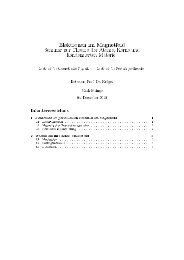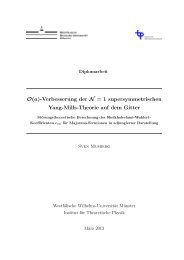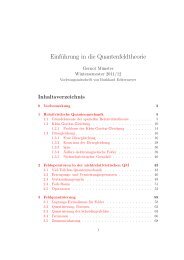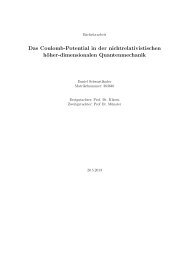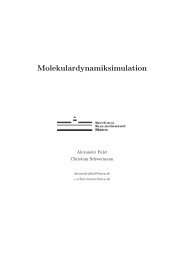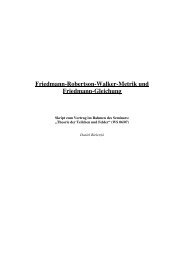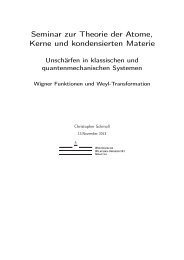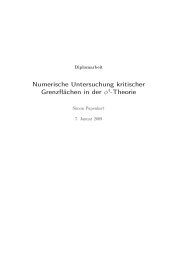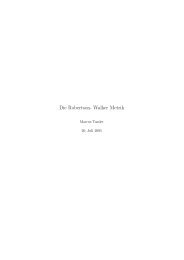Johannes Göttker-Schnetmann - Institut für Theoretische Physik ...
Johannes Göttker-Schnetmann - Institut für Theoretische Physik ...
Johannes Göttker-Schnetmann - Institut für Theoretische Physik ...
Sie wollen auch ein ePaper? Erhöhen Sie die Reichweite Ihrer Titel.
YUMPU macht aus Druck-PDFs automatisch weboptimierte ePaper, die Google liebt.
120 Anhang A. Gaußintegration und Hermitepolynome<br />
gilt <strong>für</strong> alle p ≥ p ′ ≥ 1<br />
da das Maß endlich ist.<br />
L p (R N , µ σ ) ⊆ L p ′(R N , µ σ ) ,<br />
Lemma 1 Ist c ∈ R, c < 1 , und F eine Funktion, so daß <strong>für</strong> die um y ∈ RN<br />
2γ<br />
verschobene Funktion F(· + y) ∈ L 1 (R N , dµ Lγ ) gilt, dann hat man<br />
∫<br />
dµ γ (x) exp(c(x + y) 2 )F(x + y)<br />
∫<br />
= Λ(−c) N/2 exp(cΛ(−c)y 2 ) dµ Λ(−c)γ (x)F(x + Λ(−c)y)<br />
mit Λ(c) = 1<br />
1+2γc .<br />
Beweis:<br />
∫<br />
dµ γ (x) exp(c(x + y) 2 )F(x + y)<br />
∫<br />
(<br />
)<br />
d N x<br />
=<br />
(2πγ) exp − x2<br />
N/2 2γ + c(x2 + 2xy + y 2 )) F(x + y)<br />
} {{ }<br />
1<br />
=−2γΛ(−c) (x−2cγΛ(−c)y)2 +c(2cγΛ(−c)+1)y 2<br />
∫<br />
x→x+2cγΛ(−c)y<br />
= exp(cΛ(−c)y 2 d N x<br />
)<br />
(2πγΛ(−c))<br />
)<br />
N/2Λ(−c)N/2<br />
exp<br />
(− x2<br />
F(x + (1 + 2cγΛ(−c))y)<br />
2γΛ(−c)<br />
∫<br />
= exp(cΛ(−c)y 2 )Λ(−c) N/2 dµ Λ(−c)γ (x)F(x + Λ(−c)y) ⊳<br />
Lemma 2 Sei G : R N → R eine C 1 -Funktion in L 2 (R N , dµ γ ), <strong>für</strong> die auch<br />
∂ k G, k ∈ {1, . . . , N}, in L 2 (R N , dµ γ ) liegt. Dann gilt<br />
∫<br />
∫<br />
dµ γ (x)x k G(x + y) = γ dµ γ (x)∂ k G(x + y).



